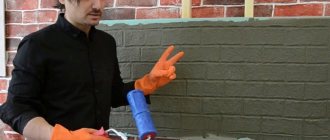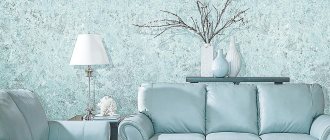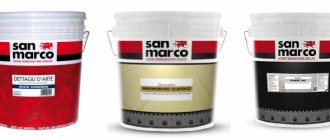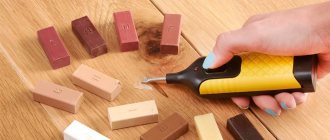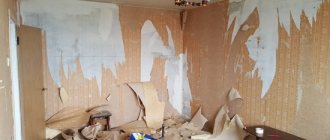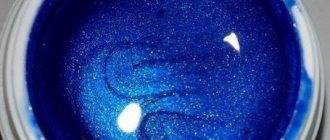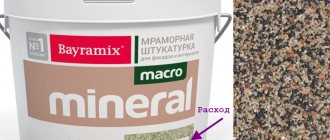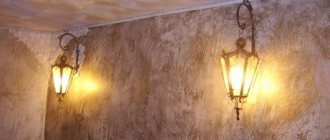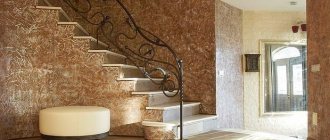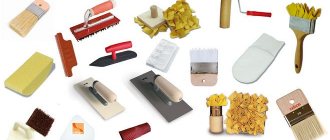How is wood waxed? Currently, many means are used to protect wood from deformation, moisture, scratches, rotting, damage by fungus and various microorganisms.
Wax impregnation not only protects wood from rotting, but also emphasizes its structure and beauty.
The tree also needs protection from solar radiation and exposure to various chemicals. Products for protecting wood give it an excellent appearance, highlighting the structure of the wood, its pattern and natural beauty.
Content:
Various varnishes, paints, and oils are used to impregnate wood. One of the most reliable and proven means of protecting wood is wax. Waxing is one of the most ancient and high-quality methods of wood processing.
Wax improves the decorative functions of wood, emphasizes its texture, and gives the surface a velvety feel. Now the industry produces a wide variety of different wax compositions for application to wooden surfaces and furniture. The material, ready for use, consists of natural wax and various additives, including oils. Tools and materials for wood impregnation. These compositions can be used immediately after opening the package. The composition gives the surface smoothness, shine, and the required shade. It reliably protects wood from destruction and moisture. Any type of wood can be waxed, but it looks best on products made from pine and spruce. Modern industry produces compositions of various colors and shades.
Features of the use of waxed products
With all the advantages of the method of treating wood with liquid wax, it should be remembered that wax is a material sensitive to high temperatures. Under their influence he “floats”. Therefore, you need to take into account the features of the room in which future furniture or wood products will be used. Although the heat resistance of some modern industrial samples of liquid wax reaches 100 0C. However, you should not wax your kitchen work surfaces. If you accidentally spill hot food or place heated dishes, traces will remain. Which can only be removed by repeated waxing.
Wax is not compatible with products containing alcohol. When choosing a care product for waxed furniture, you should carefully read the composition and instructions. In general, it is enough to simply wipe it with a dry soft cloth, and to remove dirt or remove fingerprints from time to time use special cleaners with the obligatory mark “for waxed surfaces.”
Subject to application technology and proper care, coating wood products with liquid wax will ensure a long service life and a noble appearance.
How is wood impregnated with wax?
Materials and tools:
- wax; solvent; carpenter's knife; sandpaper; stiff brush; cloth; brush.
Wood treated with a wax composition retains heat, has excellent moisture-proof properties, and a long service life.
If the surface of the wood is new and was not covered with anything before processing, then processing is performed without preliminary preparation.
If wood that has an old coating is supposed to be impregnated with wax, then the base must be prepared for the waxing procedure.
If the surface of the wood is still new, then no treatment is required before impregnation with wax.
First of all, it is necessary to clean the surface of the wood from the old coating.
If the old coating was varnish or the wood was polished, then it must be cleaned with a solvent. It must be applied several times until the varnish or polish is completely removed.
Then you need to wash off the remnants of the old coating with warm water. If after this there are hard pieces of varnish left, they must be removed with a carpenter's knife, and then these areas should be grouted using sandpaper.
Then, using a stiff brush, remove all remaining thinner and remaining varnish from the cracks of the wooden surface.
After this, you need to wait until the wood dries.
Then you need to clean the surface with sandpaper. If there are exfoliated wood fibers, they are cut off with a carpenter's knife in the direction of the fibers, and then cleaned with sandpaper.
Then, using a stiff brush, remove small remains of wood.
After the preparatory work, the surface of the wood should become even and smooth.
Composition and properties
Wax is a multicomponent substance that contains:
- esters;
- organic acids;
- hydrocarbons;
- alcohols;
- resins;
- plant pigments;
- aromatic compounds;
- mineral salts;
- water.
Its formula is highly dependent on the characteristics of the hive’s habitat and other sources of production; as a result, it is not possible to accurately characterize the composition of the finished wax for wood. The material can have various shades of yellow or beige, and is always distinguished by its plasticity, significant resistance to destruction and other physical properties common to the group.
Wax-based compositions for protecting wood structures are widely in demand because:
- prevent the appearance and development of fungal microorganisms and other parasites;
- strengthen the structure of the material and do not allow it to get wet;
The wax coating protects the wood from excessive moisture, preventing the material from rotting Source gidpokraske.ru
- give surfaces a decorative effect, forming a dense film with a stable but unobtrusive shine;
- help maintain a stable temperature.
Protecting interior items and small architectural forms made of wood from changes in temperature and humidity significantly extends their active life.
Waxing technology
Wax is an environmentally friendly and inexpensive replacement for enamels and wood varnishes.
Wax is evenly applied to the prepared smooth, dry surface. Impregnation with wax is carried out using a piece of cloth, since it does not have lint.
First, carefully process all flat areas of the tree. Then the product is applied to corners, crevices, profiles, and decorative elements.
This work is done using a small brush or toothbrush.
Impregnation of wood with wax is carried out along the direction of the fibers.
After impregnating the entire area with wax, you need to wait one hour for it to be completely absorbed. Then the excess product is carefully removed with a soft cloth.
The composition should cover the entire surface of the wood, fill all the cracks, pores, and hard-to-reach areas.
Wax impregnation gives wood strength, moisture resistance and durability.
If it is necessary to obtain additional shine, then the entire area must be re-treated. In this case, only part of the composition will be absorbed.
An additional layer is necessary to form a special film, which must be polished with a stiff brush.
Applying liquid wax
It is more convenient to apply liquid wax to a product with a hard brush, especially when it comes to embossed decorative elements. Before the first use, a new brush must be cleaned - remove excess hairs that are poorly attached and will immediately end up on the surface, which will not decorate the coating. The most suitable brushes are made from natural bristles; brushes for oil painting are suitable. There are also special brushes for liquid wax on the market. They are distinguished from ordinary brushes by the bristled bristles at the ends. On a new wooden product, homemade liquid wax is applied in one layer. After which the wooden surface is left for at least 1 hour. After the composition has been absorbed, its excess is removed with a piece of clean cloth. Otherwise, greasy stains may remain on the surface. Any non-lint soft fabric, even a waffle towel, is suitable for these purposes. The result is a beautiful, noble matte surface, the texture of natural wood becomes apparent. If desired, you can apply another layer of wax, and then polish the product using a cloth or a roll of thin metal wire. In this case, the surface will acquire a characteristic shine. For the second layer you need very little composition, since the main part has already been absorbed into the pores of the wood.
Use of waxed products
Wooden surfaces treated with a wax composition are indispensable for children's rooms, bathhouses, and residential premises, which are subject to increased environmental safety requirements.
Precautions must be taken when using such products.
Surfaces coated with the composition do not tolerate high temperatures. When heated, the wax coating floats and breaks down.
Therefore, it is not recommended to use waxing for wooden surfaces located in the kitchen. It is necessary to protect the surface of furniture treated with the composition from heating, and do not place dishes with hot food on it.
If you take the necessary precautions, wood coated with wax can be used for a long time, as it is highly durable, environmentally friendly and durable.
Similar articles
How is wood waxed? Currently, many means are used to protect wood from deformation, moisture, scratches, rotting, damage by fungus and various microorganisms.
Wax impregnation not only protects wood from rotting, but also emphasizes its structure and beauty.
The tree also needs protection from solar radiation and exposure to various chemicals. Products for protecting wood give it an excellent appearance, highlighting the structure of the wood, its pattern and natural beauty.
Various varnishes, paints, and oils are used to impregnate wood. One of the most reliable and proven means for protecting wood is wax.
Waxing is one of the most ancient and high-quality methods of wood processing. Wax improves the decorative functions of wood, emphasizes its texture, and gives the surface a velvety feel.
Now the industry produces a wide variety of different wax compositions for application to wooden surfaces and furniture.
The ready-to-use material consists of natural wax and various additives, including oils.
Tools and materials for wood impregnation.
These formulations can be used immediately after opening the package.
The composition gives the surface smoothness, shine, and the necessary shade. It reliably protects the tree from destruction and moisture. Any type of wood can be waxed, but it looks best on products made from pine and spruce.
Modern industry produces compositions of various colors and shades.
What wood wax can be: types and main characteristics
The release form and characteristics of this coating may vary significantly. Manufacturers offer solid and liquid substances that allow you to restore the integrity of the wood base. Colored wax can be used to change the shade.
Release form may vary significantly
Solid
For its production, vegetable oils and natural wax, most often beeswax, are used. Thanks to the careful selection of components, it allows you to restore the integrity of the base and give the desired shine.
Solid has the appropriate consistency
Characteristics
Hard wax is characterized by:
- high plasticity;
- increased adhesion;
- good ductility;
- versatility. Can be applied to various types of substrates to form a high-quality protective layer.
Color-matched composition allows you to repair cracks and scratches
Application method
Impregnation of wood with hard wax is carried out in the following sequence:
- preparation of tools and materials. In addition to the applied substance, you must have a grinder, impregnation, a tin container, a brush, a piece of wool or cloth;
- preparation of the base. Using a grinder, uneven surfaces, dust, and dirt are removed. Impregnation - linseed oil - is applied to clean and smooth wood using a brush. The surface is dried and polished. Several cycles are performed;
- surface treatment. Wax, previously melted in a tin container, is rubbed into the prepared base using soft, clean cloth or wool. The protective substance is applied in the direction of the wood fibers;
- drying the base for the time recommended by the manufacturer. Removing excess. After drying, wipe the surface with a cloth. If excess wax remains, stains will appear on the wood. To obtain the desired shine, the composition can be applied several times;
- grinding performed using a grinder.
Excess composition is removed mechanically
Related article:
How to remove old paint from a wooden surface : technologies for cleaning wooden surfaces, cleaning options using aerosols and gels, what are the benefits of chemicals, which wood is easiest to clean - read the publication.
Liquid
If the surface of the wood is embossed and has a characteristic pattern, it is quite difficult to properly treat the base with hard wax. The coating will be heterogeneous and will provide poor protection from external negative factors. An alternative is liquid formulations that penetrate well into hard-to-reach places. We invite you to get acquainted with their features.
Liquid compounds penetrate well into various irregularities
Characteristics
Liquid formulations:
- environmentally friendly. The absence of harmful components eliminates the negative impact on human health and the environment. They have a pleasant smell;
- increase the moisture resistance of the base;
- penetrate well into various scratches, cracks, and other irregularities on the surface of the base. Used for thread processing;
- ensure the formation of a film that helps repel dirt and dust;
- increase the service life of the wooden base.
The formed coating protects the wood from moisture
Application method
To apply the liquid composition, use a brush, roller, or spatula. Movements are made in the direction of the fibers. The consistency of the substance and the method of application ensure the treatment of hard-to-reach areas and embossed surfaces. It is most often used to protect furniture.
You can use a brush to apply
Attention! The choice of tool for applying wax depends on the base being processed.
The work is performed in the following sequence:
- the base is leveled and cleaned. The work is carried out using a grinder or sandpaper;
- the surface is treated with liquid wax. The type of tool used depends on the area being processed. For a large base, a roller is selected. For the limited – a brush. In the latter case, it is possible to form a uniform and neat coating;
- the resulting layer is thoroughly dried and polished. A soft cotton cloth is used for polishing.
For larger bases it is better to use a roller
Color
If you need to change the shade of the base, colored wax comes to the rescue. By applying it to wood, the desired shade is achieved. At the same time, the condition of the processed material is further improved. We invite you to get acquainted with the distinctive features of color compositions.
Color is selected individually
Characteristics
Colored wax allows you to:
- mask minor defects on the surface of the base. A correctly selected palette will eliminate unevenness and hide cracks;
- even out the color. If different types of wood were used to make the surface, a uniform base is formed using colored wax;
- give the base the desired shade.
Colored compounds help update the appearance of the wood base
Application method
The process of applying the colored substance is similar to that described above. First, the wood base is carefully prepared: cleaned and sanded. Then colored wax is applied to it. After hardening, the excess is removed using a convenient mechanical method.
Advice! Before starting work, study the manufacturer's recommendations and familiarize yourself with the characteristics of the colored wax.
The order of application is the same as that of other types of wax.
How is wood impregnated with wax?
Materials and tools:
- wax; solvent; carpenter's knife; sandpaper; stiff brush; cloth; brush.
Wood treated with a wax composition retains heat, has excellent moisture-proof properties, and a long service life.
If the surface of the wood is new and was not covered with anything before processing, then processing is performed without preliminary preparation.
If wood that has an old coating is supposed to be impregnated with wax, then the base must be prepared for the waxing procedure.
If the surface of the wood is still new, no treatment is required before impregnation with wax.
First of all, it is necessary to clean the surface of the wood from the old coating.
If the old coating was varnish or the wood was polished, then it must be cleaned with a solvent. It must be applied several times until the varnish or polish is completely removed.
Then you need to wash off the remnants of the old coating with warm water. If after this there are hard pieces of varnish left, they must be removed with a carpenter's knife, and then these areas should be grouted using sandpaper.
Then, using a stiff brush, remove all remaining thinner and remaining varnish from the cracks of the wooden surface.
After this, you need to wait until the wood dries.
Then you need to clean the surface with sandpaper. If there are exfoliated wood fibers, they are cut off with a carpenter's knife in the direction of the fibers, and then cleaned with sandpaper.
Then, using a stiff brush, remove small remains of wood.
After the preparatory work, the surface of the wood should become even and smooth.
How to apply wax
You can only wax dry plaster; after finishing you will have to wait at least 3 days. During this time, you need to remove all defects on the surface and remove dust.
Recommendations for working with the material:
- Liquid wax is applied using a flange cloth, for thick wax you need to use an elastic spatula.
- You can use a wide brush, but this method of application will take longer and is suitable for surfaces with relief patterns.
- The quality of the tool must be very good; fibers from the brush should not be allowed to remain on the wall.
- You need to prepare the required volume of the mixture to apply everything at once, the surface must dry at the same time, the approximate wax consumption is 50-80 g per square meter. m.
- A mixture that is too thick can be heated and diluted with water; the amount of liquid should not be more than 3% of the total mass.
- The mixture should sit for at least 7 days; to improve the adhesion of the surface to the wax, the plaster can be pre-coated with a primer and wait until the wall is completely dry.
Attention!
The wax must be applied carefully so that no excess remains on the surface. The application method depends on the quality of the plaster; a base that is too porous may absorb wax. If the surface is covered with cracks, do not touch the applied mixture.
Experienced craftsmen advise first treating the wall with colorless wax; the mixture must be diluted with plenty of water in a 4:1 ratio.
Rules for processing the applied mixture:
- After application, the wax is smoothed with a damp sponge to make the surface texture look clearer.
- The coating dries in approximately 30 minutes. After this, you need to wipe it again with a damp, clean cloth so that the surface does not become stained.
- Then the wall is rubbed down with a grinding wheel. For this, a grinder or grinder is used.
The wax will dry completely after 5 hours, and the protective film will become stronger after 13 hours. You cannot touch the wall for 3 days; in a week it will be completely dry.
Before treating the surface with wax, you must wait until the layer dries.
Waxing technology
Wax is an environmentally friendly and inexpensive replacement for enamels and wood varnishes.
Wax is evenly applied to the prepared smooth, dry surface. Impregnation with wax is carried out using a piece of cloth, since it does not have lint.
First, carefully process all flat areas of the tree. Then the product is applied to corners, crevices, profiles, and decorative elements.
This work is done using a small brush or toothbrush.
Impregnation of wood with wax is carried out along the direction of the fibers.
After impregnating the entire area with wax, you need to wait one hour for it to be completely absorbed. Then the excess product is carefully removed with a soft cloth.
The composition should cover the entire surface of the wood, fill all the cracks, pores, and hard-to-reach areas.
Wax impregnation gives wood strength, moisture resistance and durability.
If it is necessary to obtain additional shine, then the entire area must be re-treated. In this case, only part of the composition will be absorbed.
An additional layer is necessary to form a special film, which must be polished with a stiff brush.
Wax tinting
Colorless wax is used when you need to highlight the color of the plaster itself and make it more saturated. To create an antique effect, you can add golden yellow dye to the mixture. The shade is changed in cases where the plaster does not look impressive. For mixtures with acrylic components, water-based paint is used.
Often the coating becomes lighter after drying. Therefore, experts recommend waxing a small section of the wall first to see what it will look like when it dries.
Venetian plaster does not require tinting, so a transparent material is used. The golden mixture can be used to cover yellow walls or Moroccan-style trim. Decorative wax with the addition of a special pigment paste is suitable for cladding under natural stone.
To obtain a metallic shine, bronze or silver powder is used. You can stir by hand, but it is better to use special equipment. The amount of color impurities should not exceed 15% by weight of the total mass of the mixture.
Tinted bitumen mixtures help create an antique effect. For production, bitumen varnish is mixed into the molten wax. This coating is great for creating a craquelure effect.
The wax is tinted with special pigment pastes
Use of waxed products
Wooden surfaces treated with a wax composition are indispensable for children's rooms, bathhouses, and residential premises, which are subject to increased environmental safety requirements.
Precautions must be taken when using such products.
Surfaces coated with the composition do not tolerate high temperatures. When heated, the wax coating floats and breaks down.
Therefore, it is not recommended to use waxing on wooden surfaces located in the kitchen. It is necessary to protect the surface of furniture treated with the composition from heating, and do not place dishes with hot food on it.
If you take the necessary precautions, wood coated with wax can be used for a long time, as it is highly durable, environmentally friendly and durable.
How is wood waxed? Currently, many means are used to protect wood from deformation, moisture, scratches, rotting, damage by fungus and various microorganisms.
Wax impregnation not only protects wood from rotting, but also emphasizes its structure and beauty.
The tree also needs protection from solar radiation and exposure to various chemicals. Products for protecting wood give it an excellent appearance, highlighting the structure of the wood, its pattern and natural beauty.
Various varnishes, paints, and oils are used to impregnate wood. One of the most reliable and proven means for protecting wood is wax.
Waxing is one of the most ancient and high-quality methods of wood processing. Wax improves the decorative functions of wood, emphasizes its texture, and gives the surface a velvety feel.
Now the industry produces a wide variety of different wax compositions for application to wooden surfaces and furniture.
The ready-to-use material consists of natural wax and various additives, including oils.
Tools and materials for wood impregnation.
These formulations can be used immediately after opening the package.
The composition gives the surface smoothness, shine, and the necessary shade. It reliably protects the tree from destruction and moisture. Any type of wood can be waxed, but it looks best on products made from pine and spruce.
Modern industry produces compositions of various colors and shades.
Application of industrial liquid wax
Ready-made industrial forms of liquid wax are applied in accordance with the instructions on the packaging. Manufacturers include various substances that affect drying speed. There are products that, after applying the first layer, are not recommended to be left on the surface for more than 10 minutes, after which they should be immediately wiped with a cloth to remove excess coating. Some compounds take longer to be absorbed. Some manufacturers offer liquid wax in spray form. Its composition does not differ from its analogues applied with a brush, but is available in the form of a bottle with a sprayer. Just shake the can and apply the composition to the surface from a distance of 25 cm. After a while, wipe with a piece of soft cloth, evenly distributing the coating. After drying, the product can be polished to a shine if desired. Liquid wax in the form of a spray is produced both colorless and tinted. In any case, it is always worth doing a test painting of a small area before starting to treat the entire surface of the product. According to safety precautions, all materials soaked with liquid wax during work, such as rags and sponges, should be thrown away or stored in airtight containers. It does not spontaneously combust, but is flammable. The room should be ventilated during and after work.
How is wood impregnated with wax?
Materials and tools:
- wax; solvent; carpenter's knife; sandpaper; stiff brush; cloth; brush.
Wood treated with a wax composition retains heat, has excellent moisture-proof properties, and a long service life.
If the surface of the wood is new and was not covered with anything before processing, then processing is performed without preliminary preparation.
If wood that has an old coating is supposed to be impregnated with wax, then the base must be prepared for the waxing procedure.
If the surface of the wood is still new, no treatment is required before impregnation with wax.
First of all, it is necessary to clean the surface of the wood from the old coating.
If the old coating was varnish or the wood was polished, then it must be cleaned with a solvent. It must be applied several times until the varnish or polish is completely removed.
Then you need to wash off the remnants of the old coating with warm water. If after this there are hard pieces of varnish left, they must be removed with a carpenter's knife, and then these areas should be grouted using sandpaper.
Then, using a stiff brush, remove all remaining thinner and remaining varnish from the cracks of the wooden surface.
After this, you need to wait until the wood dries.
Then you need to clean the surface with sandpaper. If there are exfoliated wood fibers, they are cut off with a carpenter's knife in the direction of the fibers, and then cleaned with sandpaper.
Then, using a stiff brush, remove small remains of wood.
After the preparatory work, the surface of the wood should become even and smooth.
Finishing nuances
Industrially produced wax-based impregnations can be completely natural or contain components of synthetic origin.
- Traditional compositions give surfaces a yellowish warm tint and leave a pleasant aroma. They are best suited for processing solid wood furniture and look great in eco-style interiors.
- Synthetic additives allow you to noticeably change the color and structure of the drug, but in some cases they require special attention to the final stages of finishing. Inaccurate application can cause the formation of an uneven protective layer, and it will not be possible to cope with defects of this kind on a completely dry coating without loss.
Wood has a pleasant texture, and products made from it are characterized by a unique shade and pattern, therefore, when carrying out finishing work, they try to preserve its original appearance without changes. Light and transparent compositions are best suited for this purpose. Light darkening is achieved by using earth-colored preparations coupled with pre-treatment of surfaces with stain.
Visible coloring and tinting are performed using colored waxes. When choosing a product, you need to take into account the type of wood and clearly understand the end result of the procedure for using it.
- Mahogany is finished with compounds of the same shade.
- Coniferous wood (pine, cedar, spruce) is protected using golden-colored materials.
- Dark oak looks good when coated with black and brown mixtures.
Waxing technology
Wax is an environmentally friendly and inexpensive replacement for enamels and wood varnishes.
Wax is evenly applied to the prepared smooth, dry surface. Impregnation with wax is carried out using a piece of cloth, since it does not have lint.
First, carefully process all flat areas of the tree. Then the product is applied to corners, crevices, profiles, and decorative elements.
This work is done using a small brush or toothbrush.
Impregnation of wood with wax is carried out along the direction of the fibers.
After impregnating the entire area with wax, you need to wait one hour for it to be completely absorbed. Then the excess product is carefully removed with a soft cloth.
The composition should cover the entire surface of the wood, fill all the cracks, pores, and hard-to-reach areas.
Wax impregnation gives wood strength, moisture resistance and durability.
If it is necessary to obtain additional shine, then the entire area must be re-treated. In this case, only part of the composition will be absorbed.
An additional layer is necessary to form a special film, which must be polished with a stiff brush.
Use of waxed products
Wooden surfaces treated with a wax composition are indispensable for children's rooms, bathhouses, and residential premises, which are subject to increased environmental safety requirements.
Precautions must be taken when using such products.
Surfaces coated with the composition do not tolerate high temperatures. When heated, the wax coating floats and breaks down.
Therefore, it is not recommended to use waxing on wooden surfaces located in the kitchen. It is necessary to protect the surface of furniture treated with the composition from heating, and do not place dishes with hot food on it.
If you take the necessary precautions, wood coated with wax can be used for a long time, as it is highly durable, environmentally friendly and durable.
From this article you will learn:
- What is included in wax for woodworking Why do you need wax for woodworking How to prepare for woodworking wax How to apply wood wax correctly
Wood is a unique building material that man has used throughout his history. However, in order for wood to retain its qualities longer, it needs processing and protection. For this, different materials are used, for example, wax for wood processing.
Wax and forged products
Wax paint is well suited for processing forged metal objects. The protective film protects the base from moisture, preventing the formation and development of corrosive processes.
We recommend: Review of manufacturers of paint for galvanized roofs
Wax compounds are applied to the metal after preliminary blackening. They retain a noble dark color. If you mix paint with marine varnish in a ratio of 5:1, the resulting composition will perfectly protect forged products from atmospheric factors.
To achieve the best result, you should prime the surface with red lead, then cover it with varnish and a wax mixture mixed with gasoline, waiting until it dries completely. After this, polish thoroughly.
What is included in wood wax?
Wood wax is a decorative finishing coating. It is used applied to pure wood or in combination with other materials. On the one hand, wax prevents the penetration of excess moisture into the structure of the tree and protects it from mold, rot, and damage by insects, and on the other hand, it performs decorative functions.
When covering a wooden surface, it highlights its texture, makes it smoother, adds a slight shine and a velvety tint. Dark wax compositions are usually used in restoration, as well as to imitate antiques.
Compositions for treating wood with wax are produced in various consistencies.
Small surfaces are treated with special wax pastes; for large rooms, liquid compositions are used. There are also soft and hard restoration wax. It is used as a means to seal cracks and chips.
Wax pastes consist of three main components:
- beeswax or paraffin, which creates a soft elastic consistency that improves the polishing process; carnauba wax, which gives the finish strength and adds shine; solvent - it is necessary to give the composition optimal thickness.
Wood waxes with oil
For reliable protection, wax is used only as a finishing layer, and before applying it, it is recommended to impregnate the wood with oil. Modern professional coatings simplify the processing process.
OSMO products combine the advantages of both natural compounds:
- Penetrates deeply into the wood structure. Wood wax with oil protects the surface inside and out, helps maintain elasticity and reduces the risk of drying out.
- Strengthen the hydrophobic effect. Oils polymerize and limit the access of moisture to the upper layers of wood, even if the wax layer is damaged.
- Prevents the appearance of mold. Open pores and protection from waterlogging prevent the creation of an environment favorable for microorganisms
The products contain natural vegetable waxes and oils, accelerating drying synthetics and water-repellent additives. Thanks to the inclusion of pigments, wood wax performs protective and decorative functions, enhancing the natural color or giving the desired shade.
Why do you need wax for wood treatment?
Currently, many different methods are used to protect wooden surfaces from mechanical damage, pests and the destructive effects of the environment, including solar radiation and chemicals.
Various varnishes, paints, and oils are used to impregnate wood. One of the most reliable and popular means of protection is wax impregnation, which not only protects wood, but also emphasizes its structure and beauty. Waxing is one of the most ancient and high-quality methods of processing wooden products.
Wax is an environmentally friendly material. It is absolutely safe for health. Wood coated with this material looks more expressive and brighter. It darkens a little and, at the same time, acquires a very noble golden hue.
In addition, unlike a varnished surface, a waxed surface “breathes”, and the wood itself has an excellent smell. Nowadays, the industry produces many types of wax compositions for coating wooden surfaces and furniture. Ready-to-use mixtures include natural wax and various additives, such as oils. They can be used immediately after opening the package. Any type of wood can be waxed, but it looks best on items made from pine and spruce.
Wax for wood processing has a rich color palette.
Its different color tones can be mixed with each other. Dark compositions can easily be made lighter by adding colorless wax to them. If you apply a colorless varnish to an existing coating, this will increase the thickness of the layer without changing its color. To prevent the top fibers of the wood from swelling during processing, the wax should be slightly diluted with undiluted white spirit.
Benefits of wax oil
Previously, yacht varnish was mostly used for this purpose, and it perfectly protected the wood from the harmful effects of moisture. The composition makes the color of the wood beautiful and rich, and the structure of the fibers – clearly expressed.
Oil-wax for wood coating
But varnish has its drawbacks. It wears out and cracks, and therefore needs to be renewed regularly (every 5-6 years, depending on the intensity of use). Removing the old layer is a complex process, and applying a new coating is associated with considerable difficulties. The varnish is toxic, and therefore precautions must be taken.
Compared to it, oil-wax has a number of advantages:
- Easy to apply. Even hand-prepared compounds can be easily rubbed into a wooden surface.
- Non-toxic. These products contain caustic components, and therefore you need to be careful when working with them. But most often, oil-wax is made from natural ingredients - non-toxic and safe for human health.
- Vapor permeability. If varnish tightly clogs pores and all kinds of holes, then oil-wax preserves them. Wood “breathes”, which leads to natural ventilation and prevents rotting processes.
- Practicality. When applied correctly, these compounds provide excellent protection against sudden changes in temperature, humidity and mold.
- Deep penetration. The varnish remains on the surface of wooden products, while the oil-wax penetrates deep into the structure of the fibers and provides more reliable protection.
If previously, when replacing floorboards, you had to remove the entire layer of varnish and reapply, now this can be avoided. You simply lay down a new board and coat it with the same compound that was used on the floor. This ensures a uniform structure of the entire coating.
When applying wax, the wood fibers remain free and not constrained. If the floorboards are laid on a heated floor system, then when the temperature changes, cracks will not appear on the surface of the wood, since it will be able to expand and contract in volume without deforming.
We recommend: Features and properties of aerosol paint
How does wood wax differ from oil?
As previously noted, waxing wood can be done either using wax paste or using linseed oil with wax. Oil, when applied to the surface, deeply saturates the wood without changing its natural texture. Wax forms a film at the treatment site that protects the product from abrasion and damage.
Wax for treating wood with linseed oil protects wood from rotting and drying out. To protect furniture located outdoors, you should use a special oil-wax for wood.
Waxing is a reliable method of protecting wood surfaces. In addition, it is inexpensive, which allows it to be widely used.
Wax impregnations are environmentally friendly and safe, as well as water-repellent properties. If required, you can change the shades or even the color of the coating.
Oil waxes OSMO
The German brand OSMO offers the widest range of materials, which, unlike most other manufacturers, are based on natural oils (thistle, sunflower, soybean) and waxes (Carnauba and Candelilla). Coatings provide long-lasting and reliable protection for wood.
The assortment includes wood wax oil for all types of work:
- Hartwachs-Öl Original. Branded colorless oil wax coating for solid and cork floors, parquet, with high wear resistance and the possibility of partial repair.
- Hartwachs-Öl Anti-Rutsch. Oil with hard wax for floors with anti-slip effect.
- Uviwax® UV-protection. Wax with UV protection, used for coating walls and ceilings.
- Hartwachs-Öl Farbig. A series of color compounds with waxes for intensive coloring or tinting of wooden floors and furniture.
- Hartwachs-Öl Effect Natural. Oil with hard wax to protect and give the effect of natural untreated wood.
- TopOil. Special composition for the protective treatment of furniture and countertops in contact with food.
- Chopping Board Oil. The oil is used to treat wooden cutting boards, dishes and other wooden utensils.
- Dekorwachs Transparente Töne, Dekorwachs Intensive Töne, Dekorwachs - three series of colored oils with wax for coloring wood in bright or translucent glaze tones.
- Wohnraum-Wachs. White oil with wax, developed specifically for the treatment and renovation of wooden ceilings.
- Hirnholz-Wachs. Edge wax is used to protect against waterlogging and cracking of wood in structural elements most susceptible to destruction.
- Klarwachs. Oil with wax for hard, exotic woods.
OSMO products are suitable for kitchens and bathrooms, where humidity is always high, and are practically odorless.
How to make wax for wood processing with your own hands
Wax paste can be quickly prepared at home. Place beeswax in a metal container and melt it in a water bath. To 30% of the melted material, add 20% drying oil and 50% turpentine oil.
After thoroughly mixing the ingredients, the mixture must be cooled until it hardens. Then it is rubbed on wooden surfaces, parquet, etc.
Sealants or waxes?
Both products are designed to protect paint surfaces, but there are clear differences between them.
A sealant is something that seals. If wax seals, is it also a sealant? Technically yes, but in general, sealing is not the most important requirement for car wax.
Sealants may contain wax in their composition, but additional ingredients make it more than just wax. If the wax has a high percentage of additional ingredients, then it is no longer a wax, but a sealant.
A paint sealant is any product that forms an airtight film over a paint surface. It represents a long-term barrier that is resistant to external influences.
How to prepare for waxing wood
Before you start waxing, the surface of the wood must be prepared. First, all the indentations on it are eliminated. Next, grinding is carried out with a fine-grained abrasive, the dust is removed with a wiping cloth.
If you want to apply wax to a surface that has previously been coated in some way, then the old layers must be removed.
To remove varnish, it is allowed to use a solvent. The previous coating must be completely removed until natural wood appears.
The old coating is removed with warm water using abrasive materials.
All small patches of varnish remaining after cleaning are removed with a knife or blade. The cleaned surface is thoroughly sanded and dust is removed. Before applying wax to treat wood, the board must be thoroughly dried and sanded.
A flat, dry and smooth surface of the wood indicates that its preparation for waxing has been carried out correctly. Note that waxing old antique furniture and other wooden items perfectly protects them from damage. The wax composition can be used to cover both unpainted and varnished surfaces.
What is plaster wax
Wall wax improves the external qualities of decorative plaster and increases its service life. Processing is needed in order to create an antique effect, decorate the wall with different patterns or make it darker. A mirror shine appears on the surface, and the design looks clearer. Wax repels moisture and protects against damage that may occur after light impacts.
Compound:
- alkanes – from 11 to 13%;
- alcohol – from 1 to 1.25%;
- fatty acids – 14%;
- main component – up to 75%.
Properties:
- The dense substance is created from natural components or their synthetic substitutes.
- The coating does not dissolve under the influence of acids, alcohol or ordinary liquids.
- Wax melts at 68 degrees.
- The mixture becomes plastic and easier to apply after heating.
After applying a protective coating, the plaster will remain in its original form for many years.
Wax, when applied to plaster, creates a very interesting effect.
How wood is treated with wax
Wax pastes are a type of polishing material and, as a rule, they contain beeswax. Sold in steel cans.
To apply the paste to wooden surfaces, it is recommended to use a special swab. However, you can use a thick brush or a dishwashing sponge. Wax paste is a wonderful finishing material that can be applied to other coatings after they have been impregnated with oil.
Liquid wax for wood treatment is applied with a brush and used when treating surfaces with a large area, for example, these can be massive panels. The flooring composition has a transparent base. It is used in difficult operating conditions.
Wax impregnation products are available in various colors and shades.
Dark colors are mainly used for restoration work. Their task is to hide minor scratches and defects. The most common formulations are clear or yellow in color.
For finishing oak, impregnations in brown and black shades are used. This allows the wood to show its texture more fully. Cedar or pine, as a rule, is coated with golden impregnations, and in order to give freshness to mahogany, red mastics are selected.
By superimposing one composition on another it is possible to achieve a smooth transition of tones. Objects that often come into contact with clothing, for example, chairs or tables, are usually not coated with paints, oils and wax.
- The process of treating wood with wax.
In order to evenly apply the wax paste, special tampons are used. Several layers of the composition are applied to the surface in a circular motion. After the first layer, the surface is rubbed along the wood fibers.
A few minutes later, a second one is applied, and the surface is rubbed across the wood fibers. If difficulties arise with grouting, the paste should be heated. After applying both layers of the surface, give about a day for the solvent vapor to completely evaporate.
Then the surface is covered with wax several more times and completely dried. And finally, at the last stage, polish the coating with a soft cloth to the level you require. With sufficiently long polishing you can even achieve a mirror effect.
- Features of wood processing with wax.
Waxing is an ancient type of wood processing, considered one of the most noble. Under the influence of beeswax, the wood becomes unusually beautiful, smooth and soft. Wax, when applied to a wooden surface, highlights its natural texture, adds a slight shine, a noble yellowish tint can be seen on the surface, and the board exudes a fresh natural aroma.
Some craftsmen diligently polish the waxed surface to a mirror shine.
Nowadays, a variety of compositions for treating wood with wax are on sale. Among them you can find, for example, oleoresin wax, used in liquid form with the addition of a solvent. It is based on beeswax, pine (cedar) resin and orange oil.
When treating large areas with wax, such as floors, chemical solvents are added to solid formulations. However, after mechanical tools (irons) appeared, solid compounds can be used without dissolving them using chemicals.
Today on the building materials market you can find earth-colored wood wax. It must be used carefully, since the layer may lie unevenly, and this will not be easy to correct. To change the color of the coating, you should not use earthen paint; it is preferable to saturate the wood with a stain of the appropriate color rather than with oil.
Another useful property of waxed coatings is that they do not accumulate static electricity and, therefore, do not attract dust. It has also been noted that waxed surfaces have a beneficial effect on the emotional and physical state of a person and create a comfortable atmosphere in the room.
By repeating the impregnation procedure several times in a row, each time you increase the amount of wax per unit area of the wooden surface. Thus, you get the opportunity to control this parameter at your discretion.
Compositions for treating wood with wax may include several types of wax. Among the most famous types we will name beeswax or carnauba wax, resin. There are special artificial products created from petroleum components; they contain chemical solvents without an oil base.
How to properly apply wax to wood
A house equipped with wooden interior items looks respectable and cozy. But they need care. Treating wood with wax preserves and extends the life of furniture and floors. Each type of wax has its own characteristics in caring for a wooden surface.
Use for external and internal work
Wax is considered the best coating for decorating and protecting wood. The appearance of the tree improves and its quality characteristics are enhanced, which prolongs its life. Its different types are designed for indoor or outdoor work.
For outdoor wood treatments, wax is often combined with oil. They decorate and protect the facades of wooden housing constructions, gazebos, fences, small architectural forms and much more. Waxing the outside helps the wood resist environmental negativity, temperature fluctuations, UV rays of the sun, and high humidity. The level of surface resistance to water increases.
Wax consists of organic elements, which allows it to be used for finishing wooden products inside house buildings. It is possible to use it in children's rooms and bedrooms. Interior items made of wood retain their appearance for 5 years after treatment. A protective wax coating for the wood is formed that is velvety and pleasant to the touch.
The nature of damage to wood affects the choice of material type. Deep chips are treated with a solid compound, small defects are covered with 1-2 layers of liquid material. The shine of the parquet will return after two coatings in liquid form.
For small damage, it is convenient to purchase a wax pencil. This is an “ambulance” for removing minor scratches. To eliminate damage over large areas, restoration material is purchased in bulk containers.
Description of types of wax
Waxing is carried out by three types of wax: hard, oil, liquid. Each type is applied with its own nuances.
In solid state
Solid wax is more often used for restoration; areas with large cracks and chips are restored. The work includes a whole complex of preliminary and final stages. The tool used is a spatula.
A hard material is selected to protect the wood. It penetrates deeply and fills voids. All its properties are aimed at strengthening the base and protecting it from mechanical stress. The composition is used both indoors and outdoors. The permissible operating air temperature is 10-25 degrees above zero. The hard look restores deep damage to the wood structure.
Work with solid composition is divided into stages:
- The surface of the wood is cleaned of dust and dirt.
- The wax used to coat the wood is melted in a water bath.
- The wax mass in a liquid state is used to treat the problem area using a spatula. The material is pressed into the cracks or rubbing movements are made with a soft rag in the direction of the wood grain.
- The treated surface dries.
- Excess protective restoration layer is removed from the surface. The covering layer is sanded and polished with a cotton cloth.
Advice: deeply damaged areas are treated with more than one layer. When restoring, it is important to pre-calculate the material consumption and find the desired color.
Finishing material in liquid form
Small scratches and surfaces with small decorative details are treated with a liquid mass. The compositions are available in an assortment of shades, which allows you to choose the finish to match the color of the base.
The liquid consistency is maintained by special synthetic additives. It is more convenient to use. When applying liquid material, there are no smudges because it dries quickly. The top coat will be matte or glossy after additional polishing.
Working with liquid mass is carried out step by step:
- The old layer of paintwork is removed from the surface of the wood.
- For application, use a roller or brush.
- The second coating layer can be applied 2 hours after treating the wood for the first time.
- A soft cloth is used for sanding. To make the coating as glossy as possible, you need to polish it thoroughly.
Tip: The liquid material effectively restores the floor surface.
Colored wax composition
To restore furniture or to disguise chips in interior items, colored materials are used. Since regular wax forms an invisible transparent layer on the surface, it will not hide scratches on old furniture. Colored wax is selected to renew wood.
Manufacturers produce their own shades of finishing composition for any type of wood. When choosing them you need to know the rules.
| Wood base | The nuances of choosing wax color |
| Oak | Recommended finishes are black and brown. |
| Cedar and pine | Palette of shades in gold |
| Mahogany | Choose warm shades of orange and red |
Important: colored wax is not used when restoring chairs, tables, or armrests of furniture. Otherwise, the clothes will be stained with coloring pigment.
The color composition is applied in the same way as other types:
- Preparatory cleaning activities are being carried out.
- A decorative layer is applied.
Important: the protective layer with coloring pigment emphasizes the beauty of the natural wood pattern, and does not cover it.
Advantages and disadvantages of waxing wood
For wood, a wax coating has the following advantages:
- composition safety;
- the water-repellent characteristics of the base are enhanced;
- fungus and microorganisms do not appear;
- a shiny velvety decorative film appears;
- the composition enhances the structure of wood;
- the natural relief of the base and its warmth are emphasized;
- There is an assortment of shades of wax composition on sale.
We recommend: Types, features and scope of application of silicate paints
Impregnation for wood with wax also has disadvantages:
- the coating melts easily;
- under the influence of liquids containing alcohol, stains appear on the surface;
- spotty areas from exposure to the sun and water cannot be covered with wax;
- The countertop in the kitchen, restored with universal wax, often suffers from hot temperatures. Spots appear on the surface.
Manufacturers' choice
The quality of the restoration largely depends on the brand of wax material. Today, reviews on online sites and reviews help you understand offers from manufacturers. Company names:
- France, trademark "Liberon" and "V33". Wax putty for wood Liberon, restores damage to waxed or varnished wood and furniture.
- Italy, Borma Wachs. Various types are available. With their help, any problem can be solved. Easy to use at home. A line of wood gilding has been developed. For example, Beeswax gold silver Holzwachs.
- Russia, NPF "VAPA" and "Homa". The first company offers analogues of the best imported samples in terms of their consumer characteristics. The second one was developed - Homastic Wood Wax, frost-resistant.
Rating of popular wax materials
Wood products or furniture are common in the interior of many homes. To be able to promptly eliminate defects on the surface, it is better to always have a care product. Recommended for use:
| Brand | Technical description | Cost in rubles on Yandex.Market in 2021. |
| Liming Wax, Italy | Liquid composition with beeswax and carnauba, with white pigment. An antique effect is created. Container 0.5 l, drying speed - 2 hours. | 832 |
| "Black Bison", France | Liquid colorless composition. processes all types of wood. Sold in a range of colors. Container 0.5 l, drying speed – 24 hours. | 630 |
| Borma Wachs Stuccorapido, Italy | A soft processing material, available in pencil form. The variety of colors allows you to find the right color for local repairs. Drying speed – 2 hours. | 150 |
| White House, Russia | Solid composition in pencil form (15 g). For quick repair of wooden surfaces. Drying speed – 2 hours. | 199 |
| Hartwachs, Germany | Hard wax is applied to surfaces with intense traffic. Used in rooms with high humidity. Drying speed – 2 hours. Pencil 20 grams. | 234 |
Recipes for making wax at home
It is not difficult to prepare a restoration composition at home. Several recipes are in demand.
- beeswax – 1 share;
- turpentine (recommended oleoresin so that there is no pronounced odor) – 2 shares.
The wax is melted in a water bath. Turpentine is added to the mixture. The consistency is controlled by the amount of wax. It can be added if the composition is too liquid.
Treating wood with beeswax and olive oil, composition 2
- beeswax – 2 shares;
- olive oil – 7 shares.
The waxy material is crumbled into a jar and oil is added. The container with the contents is placed in a water bath until it is completely dissolved. The pigment creates the shade of the composition.
Tip: If the wax impregnation for wood is coated with an aerosol composition with natural resins, it will retain its appearance longer and receive a protective film.
Composition for waxing wood and methods of applying wax
